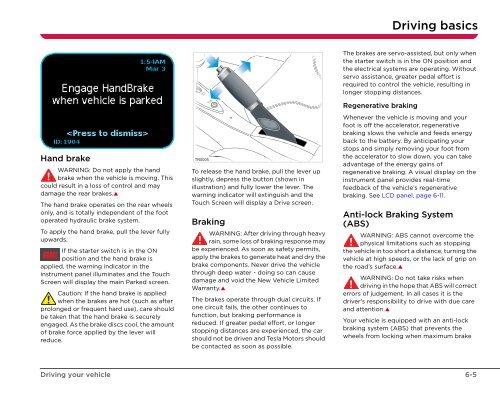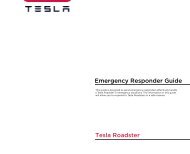You also want an ePaper? Increase the reach of your titles
YUMPU automatically turns print PDFs into web optimized ePapers that Google loves.
Driving basics<br />
Hand brake<br />
WARNING: Do not apply the hand<br />
brake when the vehicle is moving. This<br />
could result in a loss of control and may<br />
damage the rear brakes.<br />
The hand brake operates on the rear wheels<br />
only, and is totally independent of the foot<br />
operated hydraulic brake system.<br />
To apply the hand brake, pull the lever fully<br />
upwards.<br />
If the starter switch is in the ON<br />
BRAKE position and the hand brake is<br />
applied, the warning indicator in the<br />
instrument panel illuminates and the Touch<br />
Screen will display the main Parked screen.<br />
Caution: If the hand brake is applied<br />
when the brakes are hot (such as after<br />
prolonged or frequent hard use), care should<br />
be taken that the hand brake is securely<br />
engaged. As the brake discs cool, the amount<br />
of brake force applied by the lever will<br />
reduce.<br />
TR0005<br />
To release the hand brake, pull the lever up<br />
slightly, depress the button (shown in<br />
illustration) and fully lower the lever. The<br />
warning indicator will extinguish and the<br />
Touch Screen will display a Drive screen.<br />
Braking<br />
WARNING: After driving through heavy<br />
rain, some loss of braking response may<br />
be experienced. As soon as safety permits,<br />
apply the brakes to generate heat and dry the<br />
brake components. Never drive the vehicle<br />
through deep water - doing so can cause<br />
damage and void the New Vehicle Limited<br />
Warranty.<br />
The brakes operate through dual circuits. If<br />
one circuit fails, the other continues to<br />
function, but braking performance is<br />
reduced. If greater pedal effort, or longer<br />
stopping distances are experienced, the car<br />
should not be driven and Tesla Motors should<br />
be contacted as soon as possible.<br />
The brakes are servo-assisted, but only when<br />
the starter switch is in the ON position and<br />
the electrical systems are operating. Without<br />
servo assistance, greater pedal effort is<br />
required to control the vehicle, resulting in<br />
longer stopping distances.<br />
Regenerative braking<br />
Whenever the vehicle is moving and your<br />
foot is off the accelerator, regenerative<br />
braking slows the vehicle and feeds energy<br />
back to the battery. By anticipating your<br />
stops and simply removing your foot from<br />
the accelerator to slow down, you can take<br />
advantage of the energy gains of<br />
regenerative braking. A visual display on the<br />
instrument panel provides real-time<br />
feedback of the vehicle’s regenerative<br />
braking. See LCD panel, page 6-11.<br />
Anti-lock Braking System<br />
(ABS)<br />
WARNING: ABS cannot overcome the<br />
physical limitations such as stopping<br />
the vehicle in too short a distance, turning the<br />
vehicle at high speeds, or the lack of grip on<br />
the road’s surface.<br />
WARNING: Do not take risks when<br />
driving in the hope that ABS will correct<br />
errors of judgement. In all cases it is the<br />
driver's responsibility to drive with due care<br />
and attention.<br />
Your vehicle is equipped with an anti-lock<br />
braking system (ABS) that prevents the<br />
wheels from locking when maximum brake<br />
Driving your vehicle<br />
6-5







